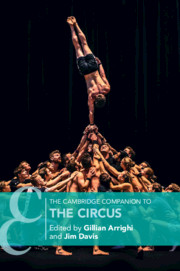Book contents
- The Cambridge Companion to the Circus
- Cambridge Companions to Theatre and Performance
- The Cambridge Companion to the Circus
- Copyright page
- Contents
- Figures
- Contributors
- Acknowledgements
- Timeline
- Introduction
- Part I Transnational Geographies of the Modern Circus
- Chapter 1 The Origins and Growth of the Modern Circus
- Chapter 2 Reconstruction, Railroads, and Race
- Chapter 3 Circus, Colonialism, and Empire
- Chapter 4 The Criollo Circus (Circus Theatre) in Argentina
- Chapter 5 The Past and Present of Czech Circus
- Chapter 6 Catching On
- Part II Circus Acts and Aesthetics
- Part III Circus
- Part IV Circus Studies Scholarship
- Bibliography
- Index
- References
Chapter 2 - Reconstruction, Railroads, and Race
The American Circus in the Gilded Age and the Progressive Era
from Part I - Transnational Geographies of the Modern Circus
Published online by Cambridge University Press: 22 June 2021
- The Cambridge Companion to the Circus
- Cambridge Companions to Theatre and Performance
- The Cambridge Companion to the Circus
- Copyright page
- Contents
- Figures
- Contributors
- Acknowledgements
- Timeline
- Introduction
- Part I Transnational Geographies of the Modern Circus
- Chapter 1 The Origins and Growth of the Modern Circus
- Chapter 2 Reconstruction, Railroads, and Race
- Chapter 3 Circus, Colonialism, and Empire
- Chapter 4 The Criollo Circus (Circus Theatre) in Argentina
- Chapter 5 The Past and Present of Czech Circus
- Chapter 6 Catching On
- Part II Circus Acts and Aesthetics
- Part III Circus
- Part IV Circus Studies Scholarship
- Bibliography
- Index
- References
Summary
The American railroad circus during the Gilded Age (1865–1900) and the Progressive Era (1900–1920) experienced a vibrant and hugely successful golden age. During that time of tremendous national growth, the circus industry reached its highest number of touring companies, boasted the largest number and variety of acts, and made the industry’s most significant number of advancements in technology and management. It connected urban and rural areas, rich and poor, and national and international audiences of all colours and races. However, this was the height of the Jim Crow era in which racial minorities, especially African Americans, experienced legal forms of discrimination and brutal violence. All aspects of American life were affected by strict racial limitations as citizenship was irrevocably linked to whiteness. This chapter argues that the American railroad circus of the Gilded Age and the Progressive Era embodied the budding imperialistic spirit of the nation and reflected, supported, and challenged the race norms of the age. It reveals how African Americans, a large American minority racial group, used the circus to advance their own careers and goals in an everchanging cultural landscape. These challenges often took the forms of economic and cultural independence.
Keywords
- Type
- Chapter
- Information
- The Cambridge Companion to the Circus , pp. 35 - 47Publisher: Cambridge University PressPrint publication year: 2021
References
Further Reading
- 1
- Cited by



